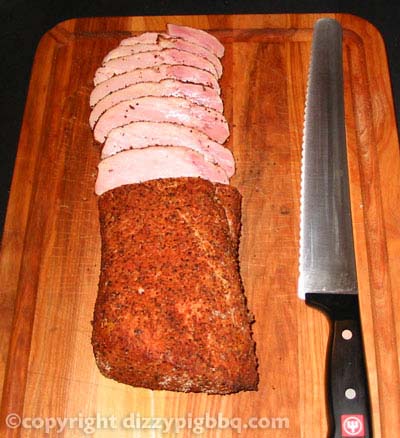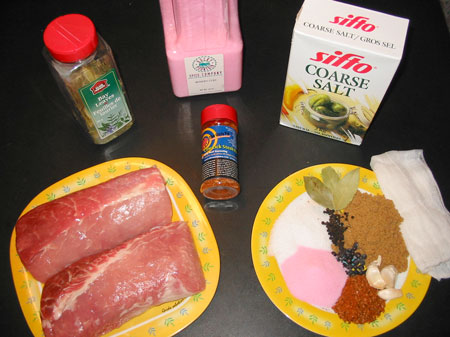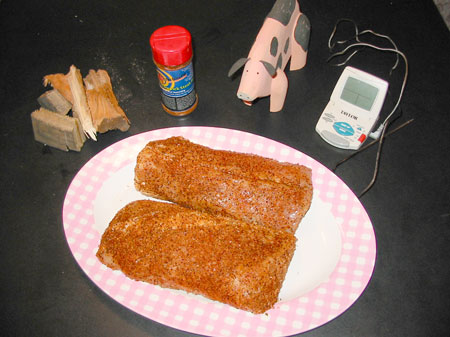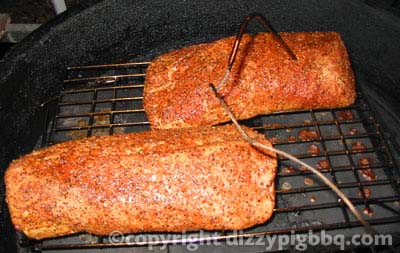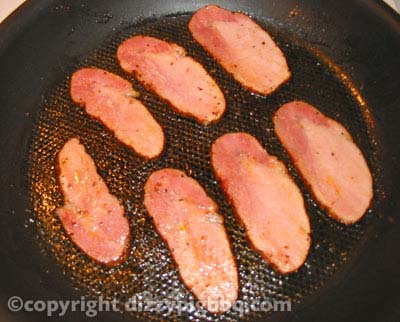| Back to Dizzy Pig Recipe Index |
|
Dizzy
Pig Cow Lick Canadian Bacon The original recipe came from Dizzy
Pig After
questions from friends I've given this
recipe to, I added
the comments in
red to clarify things. Tis' the season when our ancestors would take the steps of preserving meats, fruits and veggies for the lean winter months ahead. Nowadays of course, we just take a quick trip to the corner megamart for fresh meats and produce flown and trucked in from warmer climates. Where's the fun in that? One popular method of preserving meat is through the use of a curing brine. It's popular because is it is relatively quick, (less than a week), uses common ingredients and it makes for a terrific end product! I've learned a great deal about meat brining, curing and pickling from a good friend, Reg Pelletier, of Niagara Falls, Ontario. With a great big thanks to Reg for the original recipe and idea, here is my Dizzy Pig Spin on a Canadian favorite, back bacon. |
|
Cow
Lick'd Canadian Bacon Note: You
need to prepare and boil the brine ahead
of time to allow the brine to cool in the
refrigerator to approximately 38°F before adding the pork
loin to the brine. DO NOT put uncooked meat in
a warm brine or you will end up with spoiled
meat. Ingredients - 1 Whole Pork
loin (This is not a pork tenderloin) I
recommend using filtered or distilled
water. This eliminates Chlorine, - 1 1/4 cups Morton's TenderQuick (Available
at Ruff's Barbeque Shoppe -
1941 Youngfield St., Golden, CO - 1 tablespoon
juniper berries, slightly crushed
(Available at Amazon.com OR
http://www.myspicer.com/ - 1/2 tablespoon
whole black peppercorns, slightly crushed Put
the Juniper berries, and whole black
peppercorns
The above picture shows
the whole pork loin cut in halves. Bring all ingredients
together with the 1 gallon of water and boil
hard for about 10 minutes to ensure everything
is dissolved and flavors captured from the
garlic, bay leaves, berries, peppercorns,
etc. Putting a cover on the pot will
bring it to a boil faster. Remove pot from heat, and let
cool to 100°F or room temp.
Leaving pot covered will result in less
evaporation of the brine, but will take longer
to cool. Strain curing brine if you
prefer (I
do not) and put the brine in
your brining container. Use a non-metallic container for the
brine. I use a Rubbermaid 40 cups /
9.4 Liter food grade plastic
container. This is the perfect
size. Large enough to comfortably hold
a whole pork loin cut in halves, and small
enough for the brine to completely cover the
loin.
One side of the whole pork
loin will have a fat cap. For best
results, this fat cap and the silver skin
below it must be trimmed off. Otherwise,
the fat cap and silver skin will block the
absorbtion of the brine and that side of the
loin may not cure properly. If using a large loin, you
can use a cooks' syringe to inject strained
curing brine into the middle of the meat to
ensure complete curing. I strongly suggest injecting
the pork loin, but I do not strain the brine
first. When removing brine from the
refrigerator, be careful not to agitate the
brine and stir up the sediment. Then
simply draw the cooled brine from the middle
of the container, not the bottom. Cut the whole pork loin in half and add the loin halves to the cooled brine, and weigh down with a heavy plate to ensure they remain completely submerged in the brine. Do not allow any of the surface of the loin to be exposed to the air. Suggested cure time is 5-7 days (I go the entire 7 days). Turn the loins within the brine every day during the curing process to allow brine to reach all surface areas of the meat. After the 5-7 days of curing,
remove the pork loins from the curing
brine. Discard the curing brine.
Do not reuse the brine or try to use it for
basting the loin, or anything else. Rinse the loins under running
cold water to remove all spices, etc. At this point they can be
soaked in clean, cold water to remove some of
the saltiness of the brine. Depending on your
taste/tolerance of the salt content in cured
meat, you may want to skip this step entirely
or soak for 30 minutes or up to 2 hours. If
soaking for more than 30 miniutes, change the
water half way through. (If you do not remove some salt, the
bacon will be quite salty. Probably
too salty for most folks. Due to blood
pressure issues in my family, I soak for 2
Hours, changing the water once at 1 hour
in. As a starting point, I would
suggest soaking for 1 hour, changing the
water at 1/2 hour in. Then adjust
according to taste for the next batch) Next, pat the loins dry with
paper towel or dry cloth. Apply a thin coating
of the Dizzy
Pig Cow Lick Steak Rub as shown below.
Prepare an
indirect fire in your cooker, aiming for a pit
temperature of 225°F. I
use a Big
Green Egg but you can also do this
on a Weber. Use the
smokewood of your choice. As you can see in
the picture above, I've chosen to go with a
good-sized chunk of cherry, some Jack Daniel
oak barrel chunks and a hint o' sweet pecan. Note the
temperature probe in the picture below.
Be sure to use a thermometer like the one
pictured above to get a ball park internal
temperature without opening the cooker and
letting all the heat out. When it gets
close to the desired internal temperature,
then use a temperature probe thermometer to
spot check both ends and the middle of both
loins to determine doneness. Do not
guess at how done the meat is.
When the internal temperature
reaches 150°F, I wrap the loins in
aluminum foil. Stick the thermometer
probe back in the loin through the aluminum
foil. Continue to cook to 160°F to 165°F. This speeds up getting
through the plateau and keeps the meat
moist. When you pull the loins off the
smoker, leave them in the foil and let them
rest 1 to 1 1/2 hours before slicing.
The loins came off the cooker at 145°F internal, as it's my intention to use them as a breakfast bacon. Let the loin(s) rest for at least an hour, up to an hour and a half, otherwise the juices will end up on the cutting board instead of staying in the meat. The loins are sliced in 1/4" slices, here using my new Wustof 'Super Slicer', which does a great job with consistent results. The bacon can be fried up
immediately or kept in the fridge with much
the same shelf-life as other commercial cured
bacons. It also freezes well, especially when
pre-sliced with pieces of waxed paper placed
between the slices.
For breakfast bacon, lightly
fry the cured pork loins using a bit of oil
over medium heat until outside caramelizes a
bit and loins are heated through. Do not
overcook or you will loose the tenderness and
moisture. Give it a try, and Enjoy! Qfan |
